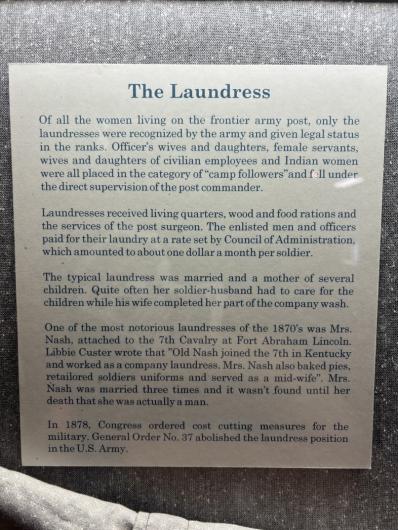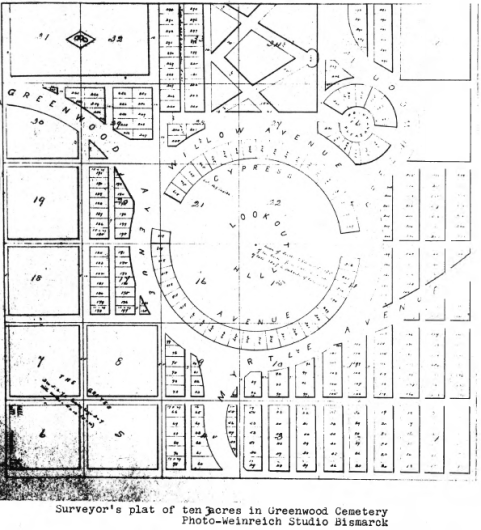“Unknown Noonan” – My Search for Mrs. Nash’s Grave
Editor’s Note: This story is a follow-up article to the original Mrs. Nash article which can be found at: https://www.blm.gov/blog/2024-06-03/laundress-mrs-nash-and-wrung-out-history
On March 6, 2024, I sent an email asking for help sharing “some intensive cultural research to determine the possible identity of a [un]marked burial on BLM land.” But this quest for uncovering the truth, really started the weekend of March 1, when I went to a flea market in Rapid City, South Dakota. During that trip, I bought a copy of Black Hills Believables because it had an interesting story from 146 years ago, of when Mrs. Nash passed away.
I thought I was done writing about Nash. I ended my last write-up on her saying “Mrs. Nash was a laundress; Annie Franklin was a laundress. For me, I answered my questions and have found new ones.” I thought that was good enough. After all, Mrs. Nash had said upon her death that she wanted no “fuss” about it. The story had a nice ending and I, as the Bureau of Land Management Archaeologist for South Dakota, didn’t feel it was my place to keep looking into my original question. She wasn’t buried on the historic grounds of the Fort Meade military reservation, and her story was bigger than just trying to find out where she was buried. But people kept asking “What’s the next step?” And I wanted to know too.
I got into archaeology when I was 16 years old. I worked as a volunteer for an archaeology crew and one day I pulled a writing slate out of the sifting bucket with the name “Lilly” inscribed on it. That’s when I was hooked. In the years that followed I found out from the archaeologist I was working under that the slate is attributed to Elizabeth Dobson, an orphan of an immigrant Irish family who ended up working as a live-in housekeeper. I don’t mention this to get into Lilly’s life, but to say finding out about people’s lives, getting answers to questions about people who haven’t gotten answers, that’s why I’m an archaeologist.
So, I decided I wasn’t done with Mrs. Nash’s story – I was determined to find where she was buried.
I had a good starting place as I knew where Nash wasn’t. I knew she wasn’t at the Old Post Cemetery at Fort Meade, that has been thoroughly disproven. In fact, her date of death on October 30, 1878, makes it impossible. Fort Meade was established on December 31, 1878. Earlier iterations of the fort such as Camp Sturgis or Camp Ruhlen were only established earlier that year and were only staffed by essential personal – patrolling troops and construction teams. I do now know where the rumor that Mrs. Nash was buried on Fort Meade originated. The last time I mentioned Annie Franklin I found she was actually the person behind the mysterious “Laundress” grave mentioned in Black Hills Believables. Since then, I’ve looked back at the Old Post Cemetery and realized that most of the headstones are replacements due to the old ones being so badly worn away. Looks like the “Laundress” tombstone did exist after all, Annie Franklin’s name was just too worn away to read it and so the story came into being.

I can also safely say she’s not at Saint Mary’s Cemetery either. Despite her connection to the church by way of her Catholic faith, her last rights being given by Father Chrysostom Foffa, head of the church at that time and rumored recipient of her supposed $10,000 donation upon her death, there is no clear evidence I’ve found that she’s buried there. The cemetery was founded in 1878, meaning she would have been one of the first persons buried at the cemetery and the cemetery’s records don’t show that. They do show the burial of an “Unknown Noonan” interred on May 13, 1892, which at first seems like a possible reburial of Mrs. Nash; however, I can prove this isn’t Nash either. I went to check the Bismarck Tribune from May 12, 13 and 14, 1892. Page three of the Thursday May 12, 1892, issue reads:
“When the doctor reached Mr. Noonan’s, having gone on No 4 passenger, he found that Mrs. Noonan had died about a half hour before in childbirth … the funeral will take place Friday on the homestead Rev Father Martin will officiate.”
Friday, as mentioned above, being Friday May 13, 1892, the date of the “Unknown Noonan” listed in St. Mary’s burial records. Reaching out to the Cemetery Manager at St. Mary’s he confirmed the only grave related to my search was this one. Without any further evidence to substantiate the idea that Mrs. Nash is buried there, I feel safe in ruling this location out as well.
Now comes the hard part amongst Fort Abraham Lincoln, Custer National Cemetery or Greenwood Cemetery, which is the most likely location of her burial?
Starting with Fort Abraham Lincoln, it is the place she would have been buried originally as soldiers, family members, and civilian retainers like laundresses were all buried on military grounds. The fort was abandoned by the Army and opened to settlers in 1891 and established as a state park in 1907. During the time after it was abandoned, graves were relocated from the fort to two places. Custer National Cemetery, if the interred was part of the military, or Greenwood Cemetery if the interred was a civilian or child. This is confirmed by signage in the park but not by park staff who have stated civilian burials not sent to Custer National Cemetery were sent to Saint Mary’s. Regardless of where internments were moved, according to staff at the park, all internments were removed from Fort Abraham Lincoln and relocated elsewhere. This leaves our last two options.

Custer National Cemetery was established in 1879 and seems the least likely out of the two for Nash’s burial. However, some online resources, such as Find-A-Grave, list Nash’s burial here under “Unknown Noonan” and within the “Main Cemetery” section. I followed up with staff at Little Bighorn National Monument, who also manage the Custer National Cemetery for records or evidence of this gravesite. According to staff, it turns out there is no marker for an “Unknown Noonan” at Custer National Cemetery. No transfer card exists for her remains and no record exists for her monument there. This leaves our only assumed option to be Greenwood Cemetery.
Greenwood Cemetery opened in 1882 and is a mostly forgotten 40-acre plot in Morton County, North Dakota, right across from the historic grounds of Fort Abraham Lincoln. I contacted county officials about the history of Greenwood and any possible records associated with it. It had an extremely short active period, being functional for 16 years and closing in 1898. The cemetery was laid out specifically with 10-acres for Catholic burials and places for fraternity burials like the Masonic Order and Odd-Fellows. It had a sprawling design plan and was referred to as a true “city of the dead” in the making. After Greenwood closed, some burials were relocated to Mandan Union Cemetery which opened that same year in 1898. Less than thirty headstones currently exist at Greenwood, one of which was only found recently due to horses using the area as pasture. This small number does not reflect the internments known about. In 2008, a water reservoir construction near the cemetery unearthed over 50 burials, all unmarked. These previously unknown remains were reburied on the grounds of Greenwood. As for records of Greenwood’s internments or transfers there are barely any. A courthouse fire burned most of the records associated with the cemetery. The graves that don’t have headstones are only identified by searching old newspaper obituaries per a 1974 catalog of the cemetery.

Just to be sure, I checked with the groundskeeper and archivist of Mandan Union Cemetery to see if there was any chance, she was relocated a third time. The answer was expected. No records were located related to Mrs. Nash, Mrs. Noonan or Unknown Noonan and no marker related to those names is located on the grounds.
It seems Mrs. Nash can only be at Greenwood Cemetery, or, seemingly less likely, Saint Mary’s if only due to lack of knowledge on Greenwood’s internments and lack of records on Saint Mary’s part. Fort Abraham Lincoln maintains civilian burials were moved, so she can’t be there. Greenwood had a 10-acre section allotted to Catholics, which Mrs. Nash was- assuming she would be reburied with that in mind. Mrs. Nash had no living relatives present to tend to her remains and the harassment she faced after her death made her a pariah. Then the lack of clarity where she was buried all these years later can be attributed to this, Greenwood falling out of public consciousness, and the subsequent loss of records from the courthouse fire - making almost any trace of her disappear.
In many ways this search ended as expected, even after contacting so many places and combing through dates and records there is always only so much which can be done. Unfortunately, the best answer is that Mrs. Nash is buried in an unmarked grave, somewhere not far from where she died. Historical mysteries are often disappointing. You can pull a thread as much as you want but sometimes it’s not stuck, it’s just cut short. This isn’t necessarily the end though, there is still some good work to be done, especially in helping to preserve Greenwood cemetery, something that is actively being done by Morton County.
Although she may not be marked in being at Greenwood, in some way I hope in doing all this work I can do something that 146 years failed to give to Mrs. Nash. In some respects, this is the best way for my work with Nash to end. I may not have found her exact grave, but if it’s where I think it is I can help to make sure it’s protected by spreading the word of where she likely has come to rest, barring new discoveries of documents or records.
Sorry for making such a fuss, Mrs. Nash.
Catherine Oberheim, BLM South Dakota Field Office archaeologist
Related Stories
- Secretary Deb Haaland visits with Ancestral Lands Conservation Corps crew working to stabilize Lowry Pueblo
- Full Circle: BLM and Special K Ranch Plant Native Sagebrush Seedlings
- From the Ground Up: Small Crew Makes Big Impact
- BLM T. rex featured at Smithsonian Event
- Restoring Box Elder Creek: A Journey Through Time and Land
Office
111 Garryowen Road
Miles City, MT 59301
United States
